Parallel twins and inline triples have defined the modern chapter of Triumph’s storied history. The former powers the nostalgic Bonneville range. The latter sits at the center of the brand’s roadster, adventure, and cruiser collections. Going forward, the all-new TR Series will add single-cylinder entries to Triumph’s lineup with the arrival of the 2024 Speed 400 and Scrambler 400 X.
The two small-capacity offerings are the fruits of a joint venture between the British marque and Indian manufacturer Bajaj. Drawing on the expertise of both firms, the designs were born at Triumph’s Hinckley headquarters, while Bajaj pitched in on the engineering side. Named after the TR Trophy models of the 1960s and ‘70s, the collaborative project brings single-powered Triumphs to a new generation of riders.
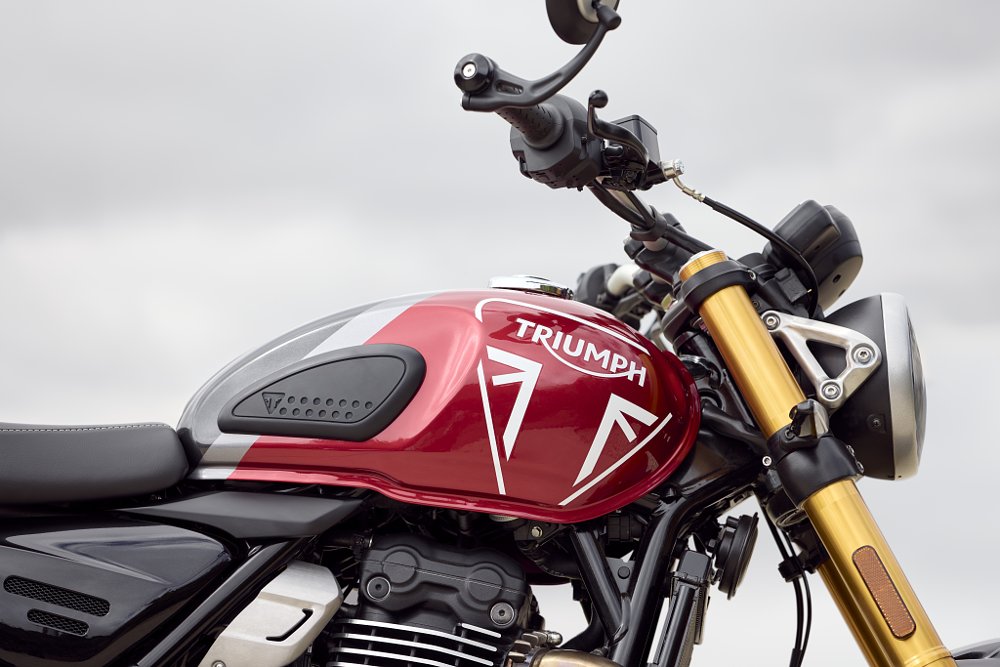
After five long years in development, the Speed 400 and Scrambler 400 X will roll into the all-important Indian market this summer. While the duo won’t reach U.S. shores until December, the TR Series is poised to challenge the competition right out of the gate, with features rarely seen on beginner-friendly bikes.
Single-minded
Both the Speed 400 and Scrambler 400 X champion an all-new four-valve, DOHC, 398 cc single-cylinder engine. Liquid cooling regulates the thumper’s operating temps, but cooling fins on the cylinder heads and header clamps retain the retro aesthetic. On the inside, a finger-follower valve train and low-friction DLC cylinder coating further refine the package.
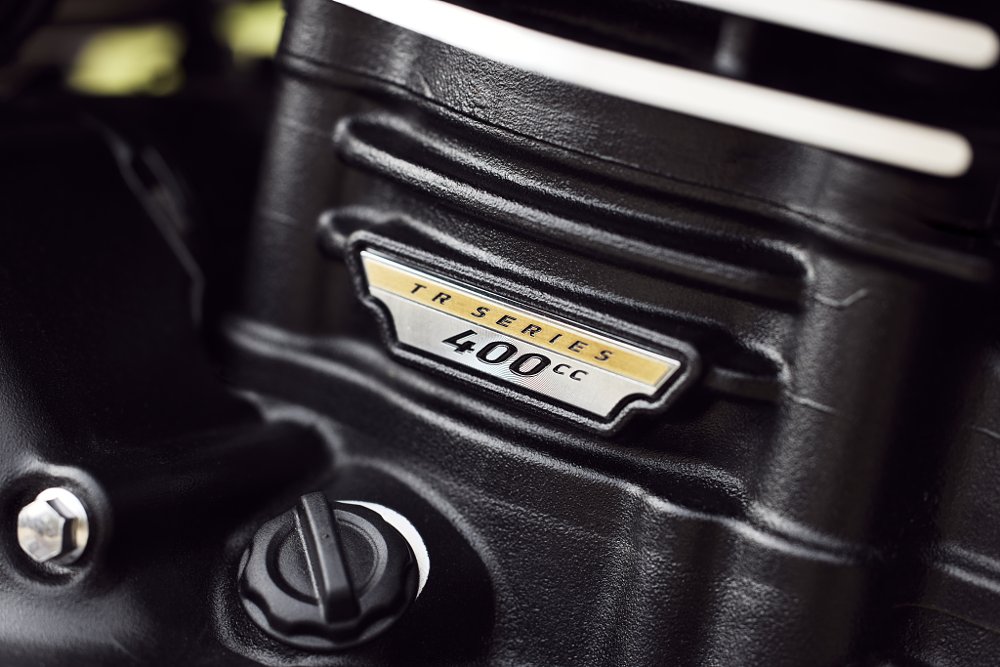
Triumph says the Bosch electronic fuel injection and ride-by-wire maintain consistent power delivery throughout the rev range and a properly weighted and balanced crankshaft polishes the powerplant’s low-speed manners. Thanks in part to a 12:1 compression ratio, the mill musters 39.5 horsepower (claimed) at 8,000 rpm and 27.7 foot-pounds of torque (claimed) at 6,500 rpm.
In both models, the engine drinks from a 13-liter (3.43-gallon) gas tank and sends power to the rear wheel via a six-speed gearbox and a chain final drive. To satisfy both regulatory standards and Triumph’s styling standards, an underslung catalytic converter box and primary silencer seamlessly integrate into the exhaust. The only difference between the two systems lies in the Speed’s single end can and the Scrambler’s twin-pipe silencer. The two models diverge further from there.
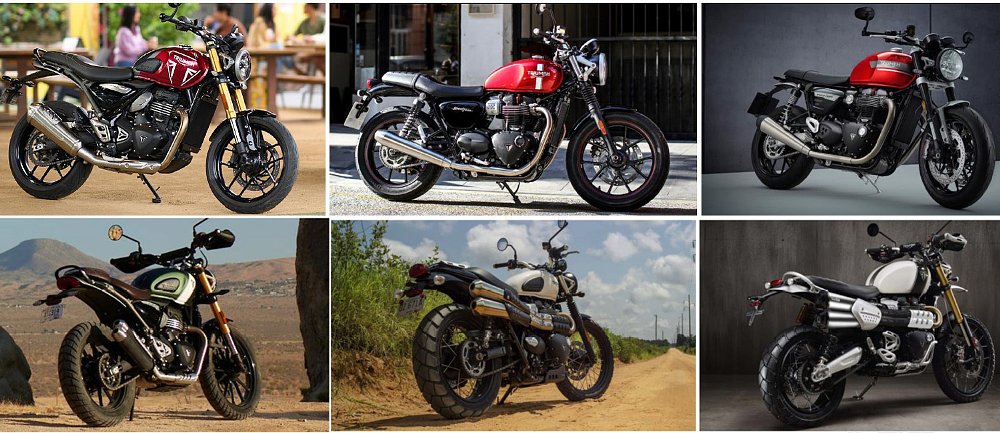
Family ties
Triumph fashions the Speed 400 after its Speed 900 and Speed 1200 Modern Classics. In that vein, the model dons round bar-end mirrors and a stylish single bench seat. The classically shaped fuel tank flaunts both knee cutouts and a two-tone livery. Those retro roadster roots inform more than its cosmetics, though.
A new tubular steel frame (with bolt-on subframe) and twin-sided aluminum swingarm lay the foundation for the TR Series. The Speed 400 achieves a sporty stance with a 43 mm inverted fork and a rear monoshock offering 140 mm (5.51 inches) and 130 mm (5.11 inches) of travel, respectively. The resulting 31.1-inch seat height courts beginners and the inseam-challenged alike. A 170-kilogram (374.8-pound) listed curb weight only augments that approachability.
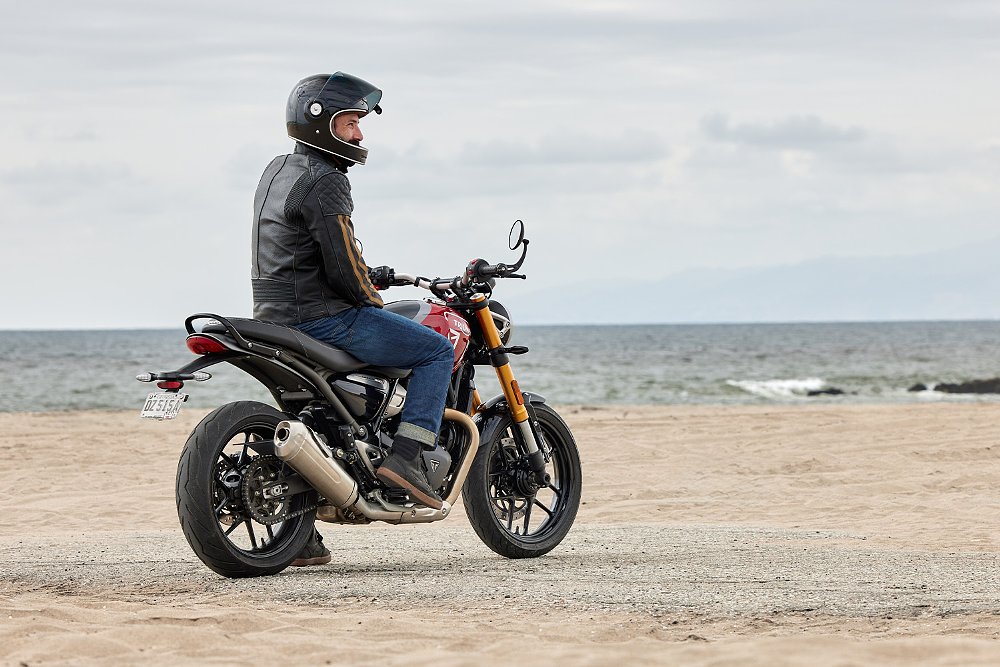
As the name suggests, Triumph fancies the Speed 400 as a performance benchmark in the category. Shod in Metzeler Sportec M9RR tires, the 10-spoke, 17-inch wheelset supports those aims. A 24.6-degree rake and 54.21-inch wheelbase put that that sticky rubber to good use. To scrub off speed, Triumph entrusts a four-piston binder and 300 mm disc at the fore and a floating caliper paired to a 230 mm rotor aft. Dual-channel ABS governs both ends.
Save for the 320 mm front disc and switchable rear ABS, the braking system remains largely unchanged on the Scrambler 400 X. For the Scrambler, Triumph also boosts suspension travel on both the 43 mm inverted front end and rear shock to 5.91 inches. The V-spoke 19-inch front and 17-inch rear wheels wearing Metzeler Karoo Street tires also speak to the model’s dual-terrain capabilities.
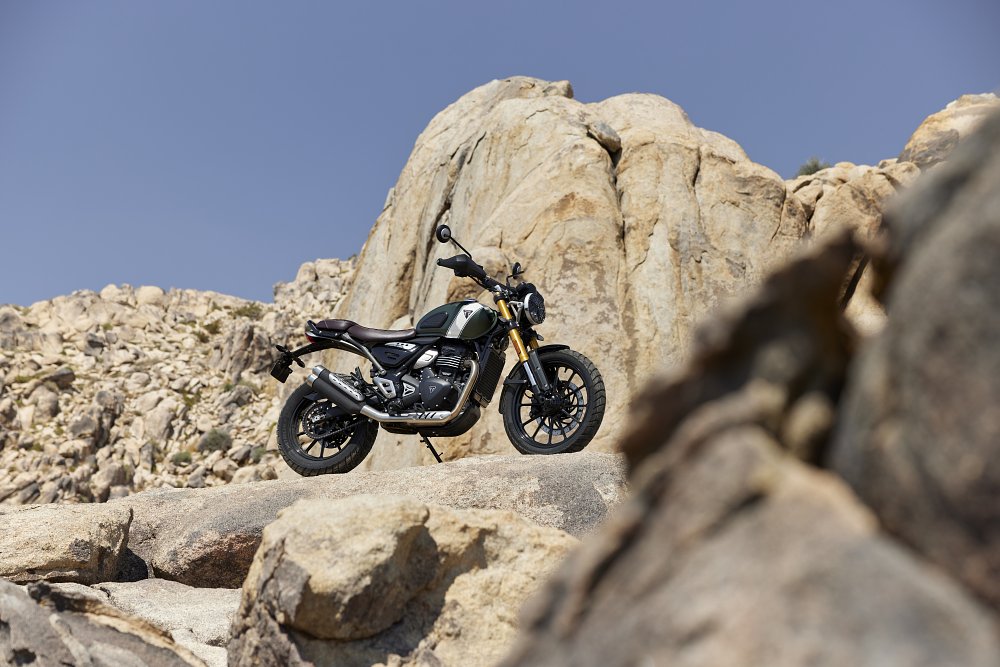
Those chassis modifications may seem minor, but they certainly show up in the bike’s dimensions. Seat height rises to a scrambler-appropriate yet manageable 32.87 inches. Similarly, the wheelbase extends to 55.82 inches, while the rake sharpens to 23.2 degrees. The Scrambler 400 X also gains nearly 20 pounds, with a listed wet weight of 179 kilograms (394.6 pounds). Much of that weight gain is accounted for my standard-fitted, off-road accessories such as an impact-absorbing sump guard, headlight grille, steel radiator guard, and scrambler-style mudguard. The rider benefits from hand guards and a bolt-on handlebar brace with a Triumph-branded roll pad. Lastly, an aluminum grab rail helps maneuver the bike out of tough terrain while also providing a hand-hold for passengers.
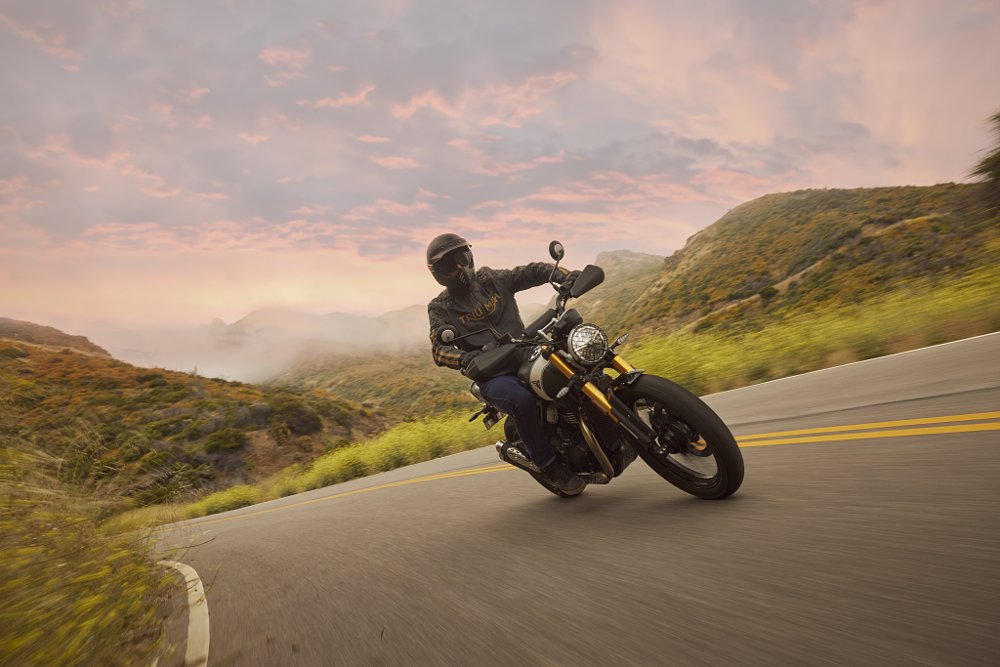
In the styling department, a two-piece seat design sets the Scrambler apart from its sporty sibling. Just like the Scrambler 900 and Scrambler 1200 before it, the 400 X boasts a unique blend of rugged and refined with timeless paint schemes, subdued graphics, and Triumph’s classic triangle badge. When it comes to looks and hardware, the Scrambler 400 X and Speed 400 take divergent paths, but technology serves to unify the TR line.
Tech-savvy
Most manufacturers build entry-level models on a budget. Outfitted with Bosch-developed traction control, a torque-assist clutch, USB charging socket, and all-around LED lighting, the Speed 400 and Scrambler 400 X challenge that established order. To bridge the gap between past and present, Triumph complements the analog speedometer with a full-feature LCD display. In addition to a digital tachometer, the panel also reports remaining fuel, range, and consumption (current and average). A gear indicator, two trip meters, and service indicators round out the digital display.
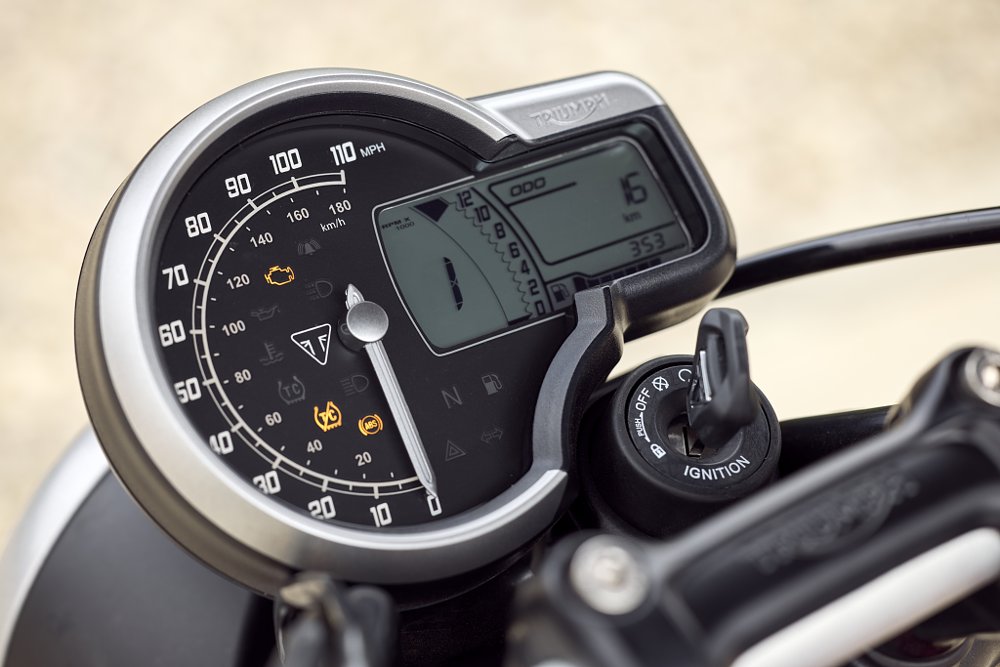
For both commuters and travelers, Triumph pre-enables the system to fit an accessory tire pressure monitoring system and heated grips. In many markets, TR-Series models also come with an anti-theft immobilizer. Unless the security system detects the key’s transponder chip nearby, it electronically disables engine by isolating critical circuits. Customers hoping to reinforce those security measures can turn to Triumph’s components catalog, which also offers more than 25 styling, comfort, and luggage accessories, as well.
A fitting finish
For an exclusive look at the Speed 400 and Scrambler 400 X, Triumph invited us to the official TR Series unveiling at London’s Bike Shed Moto Co. Unfortunately, the in-the-metal encounter didn’t include a first fire-up, but it revealed additional fit and finish details. From the prominent metal flake in the Speed’s Carnival Red paint to the precision of the Scrambler’s pressed side plate, the promo photos don’t do all the cosmetic features justice.
A closer look also drew more parallels between the TR Series and its twin-powered stablemates. Aside from the mode button on the Speed Twins and Scramblers, the 400 and 400 X’s grips, pegs, and switchgear closely resemble the middle- and heavy-weight offerings. Again, we couldn’t power up the display bikes, but the TR switchgear returned the same tactile experience as its bigger, Bonneville-based siblings, highlighted by positive button engagement and feedback.

Whereas the Speed Twin and Scrambler families earn Brembo braking systems, the 400s opt for calipers by ByBre. Triumph didn’t disclose as much in TR marketing materials but the Brembo subsidiary is a fitting supplier for the lightweight, novice-oriented runabouts. In contrast, Triumph designers thoughtfully tucked the TR horn just below the frame’s head tube, while that same component is outboard-mounted (left) on the Twins.
Lastly, throwing a leg over each model illustrated the benefits of low seat heights. Both monoshocks yielded moderate sag, reinforcing my flat-footed confidence. At five feet, 10 inches tall, with a 32-inch inseam, I effortlessly lifted the sub-400-pound 400s off their kickstands with a slight bend in my knees. I’d expect a similar experience for riders north of five feet, seven inches and at least a 30-inch inseam.
Best ability is availability
Triumph has yet to announce pricing for Speed 400 and Scambler 400 X in either India or the United States. The brand plans to release those details closer to the official launch (in each respective market). However, we do know that all TR models include a two-year, unlimited-mileage warranty and roadside assistance. With 10,000-mile service intervals, running costs should remain low too. Expect to see more on Triumph’s TR Series as the Speed 400 and Scrambler 400 X roll out over the coming months.
| 2024 Triumph Speed 400 | 2024 Triumph Scrambler 400 X | |
|---|---|---|
| Price (MSRP) | TBA | |
| Engine | TR Series 398cc, liquid-cooled, four-valve, single-cylinder | |
|
Transmission, final drive |
Six-speed, chain | |
| Claimed horsepower | 39.5 @ 8,000 rpm | |
| Claimed torque | 27.7 foot-pounds @ 6,500 rpm | |
| Frame | Tubular steel, bolt-on subframe | |
| Front suspension | 43 mm fork; 5.51 inches (140 mm) of travel | 43 mm fork; 5.91 inches (150 mm) of travel |
| Rear suspension | Monoshock; 5.11 (130 mm) of travel | Monoshock; 5.91 inches (150 mm) of travel |
| Front brake | Radial-mounted four-piston caliper, 300 mm (11.8-inch) disc with ABS | Radial-mounted four-piston caliper, 320 mm (12.6-inch) disc with ABS |
| Rear brake | Floating caliper, 230 mm (9.1-inch) disc with ABS | |
| Rake, trail | 24.6 degrees, 4.01 inches (102 mm) | 23.2 degrees, 4.25 inches (108 mm) |
| Wheelbase | 54.21 inches (1,377 mm) | 55.82 inches (1,418 mm) |
| Seat height | 31.10 inches (790 mm) unladen | 32.87 inches (835 mm) unladen |
| Fuel capacity | 3.43 gallons (13 liters) | |
| Tires | Metzeler Sportec M9RR 110/70 R17 front, 150/60 R17 rear | Metzeler Karoo Street 100/90 R19 front, 140/80 R17 rear |
| Claimed weight | 374.78 pounds (170 kilograms) wet | 394.63 pounds (179 kilograms) wet |
| Available | December 2023 | |
| Warranty | 24 months | |
| More info | triumphmotorcycles.com | |

 Membership
Membership








